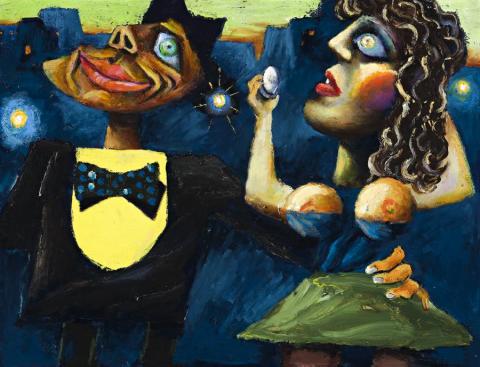FLIRTATION, 1954
ALBERT TUCKER
oil on composition board
62.5 x 81.0 cm
titled and dated verso: FLIRTATION / 19551
Barbara Tucker, Melbourne
Bonhams & Goodman, Melbourne, 23 April 2007, lot 634
Corporate Collection, Melbourne
Private collection, Sydney
Albert Tucker, Imperial Institute, London, 11 April – 8 May 1957, cat. 5
Uhl, C., Albert Tucker, Lansdowne Press, Melbourne, 1969, cat. 9.31
Head, 1951, oil and gouache on cardboard, 24.2 x 31.8 cm, collection of The British Museum, London
Albert Tucker is unrivalled for the power and impact of his imagery - individual, savage, at times demonical, always unforgettable. Flirtation 1954 is a classic example, belonging to that highly productive year, 1954, which saw the creation of other masterly works such as Killing, Encounter, and Duel, all in the collection of the Heide Museum of Modern Art, Melbourne, and Assassin in the Art Gallery of Western Australia, Perth, where blood flows from the screen into the very cinema itself. The early-to-mid-fifties was an important time for Tucker with solo exhibitions in Amsterdam, Paris, and Rome, as well appearing in the Venice Biennale of 1956. The following year saw his London exhibition which included Flirtation among other such riveting works as Apocalyptic Horse 1954 in the Art Gallery of New South Wales, Sydney, and Footballers 1955 of the National Gallery of Victoria, Melbourne. In 1957 Lunar Landscape was purchased by the Museum of Modern Art, New York, his first work to be in public collection.
In his 1940s paintings of Images of Modern Evil, Tucker recorded a savage reaction to the wartime array of happy tarts and eager soldiers, as in the vicious imagery of Victory Girls 1943 and Soldier with Victory Girl 1945, both in the National Gallery of Australia, Canberra.The vamp became the vampire. Flirtation continues the theme of street nightlife, translated from St Kilda Road to Europe and influenced by experiences of Paris, Frankfurt and Rome. In Paris, especially under the influence of Picasso and the art brut of Dubuffet, as seen in Rue St Denis 1951, and the German Expressionism of Otto Dix and George Gross, Tucker continued to explore the grossness of sexuality in all its carnality, as typified by The Old Eve 1951 (National Gallery of Australia) and Girl 1951 (Art Gallery of Ballarat, Victoria). His biting observations of humanity and inhumanity included guilt and torment, reaching a new height in the moving Judas 1955 (National Gallery of Victoria), the figure choking on betrayal.
When the dramatically powerful Flirtation was exhibited in London in 1957, Tucker grouped it with other like-minded works under the title 'Man and His Condition' - images of macabre horror, gothic heads and compelling iconography. While the eerie blackout of Image of Modern Evil 24 1945 (National Gallery of Australia) may have given way to peacetime darkness, the metaphorical implications of night still reign. Street lamps puncture the night with piercing light. Figures are bathed in a lurid glow as the sensual atmosphere palpitates with expectancy. Harsh, discordant colour adds to the nightmare as profiles reveal the depravity of the inner self. The smile of lustful intent and expectant pleasure, reaches out to take. A mirror held in hand, the lady only has eyes for herself. Vanity is set within the context of lust.2 There is no condemnation, rather empathy with the human condition for, as Tucker said of some German prostitutes, 'they were working the only way they could survive.'3 Compositionally if not thematically, Flirtation derived from a 1950 gouache. Significantly it was titled 'Lovers'.4
1. Although inscribed '1955', the date of Flirtation was given as 1954 in the catalogue to Tucker's 1957 exhibition at the Imperial Institute, London
2. In Renaissance art, vanity was often represented as a naked woman with comb and mirror, attending her hair
3. Albert Tucker quoted in Mollison, J., and Bonham, N., Albert Tucker, Macmillan, Melbourne, 1982, p. 56
4. See Albert Tucker: The Endurance of the Human Spirit, Lauraine Diggins Fine Art, Melbourne, 2000, p. 6
DAVID THOMAS
